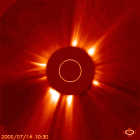 back to spaceweather.com Coronal mass ejections (CMEs) are gigantic bubbles of electrified gas that billow away from the Sun. They can carry as much as 10 billion tons of solar material and trigger spectacular geomagnetic storms if they hit Earth's magnetosphere. CMEs, which usually travel at speeds between 500 and 1500 km/s, take 2 or 3 days to cross the 150 million km divide separating the Sun and Earth.
This animation shows a "full halo" coronal mass ejection recorded by SOHO coronagraphs on July 14, 2000. The many speckles in the latter half of the movie are energetic particles from a related solar flare bombarding SOHO's electronic detectors. |
